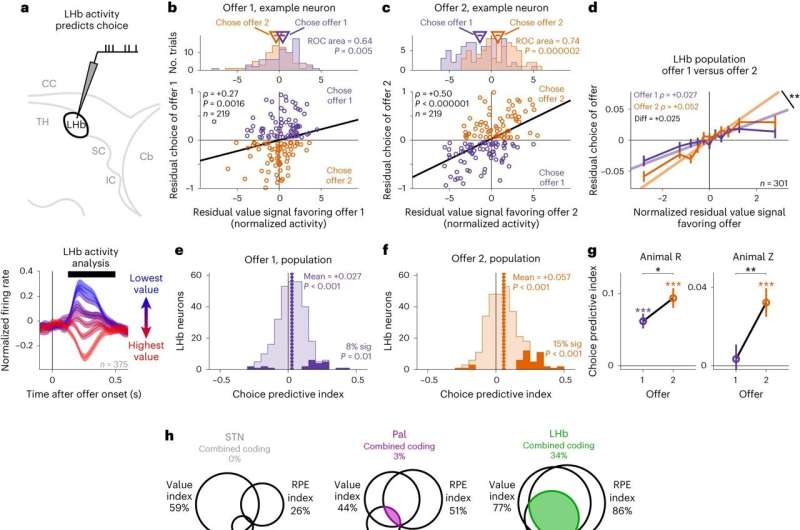March 2, 2024 feature
This article has been reviewed according to Science X's editorial process and policies. Editors have highlighted the following attributes while ensuring the content's credibility:
fact-checked
peer-reviewed publication
trusted source
proofread
Study unveils the role of a neural substrate in the lateral habenula in value-based decision-making

In their everyday lives, humans often weigh the value of different options and decide how to act based on this mental evaluation. This process, known as value-based decision-making, has been the topic of numerous studies rooted in psychology, neuroscience and economics.
While value-based decision-making implies that humans making decisions attribute objective values to different possible choices, in many cases such objective values are unattainable, thus the values attributed to choices are subjective. The neural processes supporting these subjective evaluations, which are often linked to the value of uncertain rewards they might obtain following their decision, remains poorly understood.
Researchers at Washington University School of Medicine and Washington University recently carried out a study aimed at better understanding neural processes. Their paper, published in Nature Neuroscience, identifies a neural substrate in the lateral habenula (LHb) that could contribute to the subjective computation of decision values and future rewards.
"Behavioral and economic theory dictate that we decide between options based on their values," wrote Ethan S. Bromberg-Martin, Yang-Yang Feng and their colleagues in their paper. "However, humans and animals eagerly seek information about uncertain future rewards, even when this does not provide any objective value. This implies that decisions are made by endowing information with subjective value and integrating it with the value of extrinsic rewards, but the mechanism is unknown."
As part of their study, Bromberg-Martin, Feng and their collaborators released a series of tasks in Amazon's Mechanical Turk, which were completed by 824 human participants between 18 and 55 years of age. These participants received money for completing these tasks and the amount depended on how well they performed.
![a,b, Choice procedure during the multi-attribute information choice tasks for humans (a) and monkeys (b). Each offer had four bars indicating the possible reward outcomes, with the height of each bar indicating the reward size and a color indicating whether it would provide an informative cue indicating the outcome. c, Examples showing offers that differ in several attributes, including expected reward (E[r]), uncertainty (Unc[r]) and informativeness (Info versus Noinfo). d, Info offers granted access to informative cues indicating the upcoming reward outcome (red), whereas Noinfo offers did not (blue). For the monkey task shown here, all offers also had a final reveal shortly before outcome delivery to allow animals to physically prepare to consume the juice rewards in all trials. Credit: Bromberg-Martin et al. (Nature Neuroscience, 2024). Study unveils the role of a neural substrate in the lateral habenula in value-based decision-making](https://scx1.b-cdn.net/csz/news/800a/2024/study-unveils-the-role.jpg)
Concurrently, the researchers also carried out a series of experiments involving four adult rhesus monkeys, who were rewarded with fruit juice. These monkeys completed two versions of the same task, while the team stimulated regions of their brain and observed their neural activity.
"We show that human and monkey value judgements obey strikingly conserved computational principles during multi-attribute decisions trading off information and extrinsic reward," wrote Bromberg-Martin, Feng and their colleagues. "We then identify a neural substrate in a highly conserved ancient structure, the LHb. LHb neurons signal subjective value, integrating information's value with extrinsic rewards, and the LHb predicts and causally influences ongoing decisions. Neurons in key input areas to the LHb largely signal components of these computations, not integrated value signals."
The LHb is a region in the dorsomedial surface of the thalamus that has often been implicated in numerous mental disorders, including schizophrenia, depression, and substance abuse disorder. The findings gathered by the team provide a possible explanation for the role of the LHb in psychiatric disorders.
"Our work may explain why alterations in the LHb could have broad effects on mood and motivation in everyday life," the researchers wrote. "Its highly integrated code means that it could be engaged by diverse motivational goals."
Overall, the findings of this study suggest that the LHb simultaneously fulfills two key functions, namely that of helping primates to learn what environments produce advantageous outcomes and giving them the motivational push to access these environments. These functions, which support each other, are often impaired in individuals with various mental disorders.
The results gathered by the research team could soon inspire further studies examining the LHb in the context of subjective value-based decision-making. In addition, they could contribute to future efforts aimed at developing therapeutic interventions targeting the LHb.
More information: A neural mechanism for conserved value computations integrating information and rewards. Nature Neuroscience(2024). DOI: 10.1038/s41593-023-01511-4.
© 2024 Science X Network



















